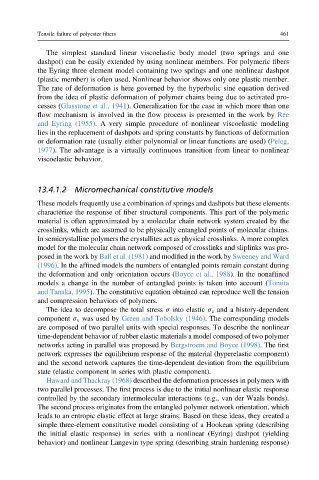Page 488 - Handbook of Properties of Textile and Technical Fibres
P. 488
Tensile failure of polyester fibers 461
The simplest standard linear viscoelastic body model (two springs and one
dashpot) can be easily extended by using nonlinear members. For polymeric fibers
the Eyring three element model containing two springs and one nonlinear dashpot
(plastic member) is often used. Nonlinear behavior shows only one plastic member.
The rate of deformation is here governed by the hyperbolic sine equation derived
from the idea of plastic deformation of polymer chains being due to activated pro-
cesses (Glasstone et al., 1941). Generalization for the case in which more than one
flow mechanism is involved in the flow process is presented in the work by Ree
and Eyring (1955). A very simple procedure of nonlinear viscoelastic modeling
lies in the replacement of dashpots and spring constants by functions of deformation
or deformation rate (usually either polynomial or linear functions are used) (Peleg,
1977). The advantage is a virtually continuous transition from linear to nonlinear
viscoelastic behavior.
13.4.1.2 Micromechanical constitutive models
These models frequently use a combination of springs and dashpots but these elements
characterize the response of fiber structural components. This part of the polymeric
material is often approximated by a molecular chain network system created by the
crosslinks, which are assumed to be physically entangled points of molecular chains.
In semicrystalline polymers the crystallites act as physical crosslinks. A more complex
model for the molecular chain network composed of crosslinks and sliplinks was pro-
posed in the work by Ball et al. (1981) and modified in the work by Sweeney and Ward
(1996). In the affined models the numbers of entangled points remain constant during
the deformation and only orientation occurs (Boyce et al., 1988). In the nonaffined
models a change in the number of entangled points is taken into account (Tomita
and Tanaka, 1995). The constitutive equation obtained can reproduce well the tension
and compression behaviors of polymers.
The idea to decompose the total stress s into elastic s e and a history-dependent
component s v was used by Green and Tobolsky (1946). The corresponding models
are composed of two parallel units with special responses. To describe the nonlinear
time-dependent behavior of rubber elastic materials a model composed of two polymer
networks acting in parallel was proposed by Bergstroem and Boyce (1998). The first
network expresses the equilibrium response of the material (hyperelastic component)
and the second network captures the time-dependent deviation from the equilibrium
state (elastic component in series with plastic component).
Haward and Thackray (1968) described the deformation processes in polymers with
two parallel processes. The first process is due to the initial nonlinear elastic response
controlled by the secondary intermolecular interactions (e.g., van der Waals bonds).
The second process originates from the entangled polymer network orientation, which
leads to an entropic elastic effect at large strains. Based on these ideas, they created a
simple three-element constitutive model consisting of a Hookean spring (describing
the initial elastic response) in series with a nonlinear (Eyring) dashpot (yielding
behavior) and nonlinear Langevin type spring (describing strain hardening response)

